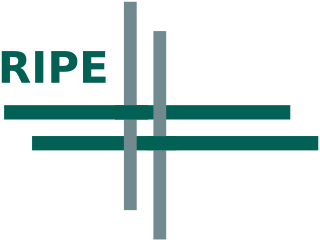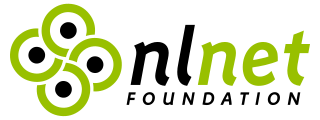
The history of the Internet has its origin in the efforts of scientists and engineers to build and interconnect computer networks. The Internet Protocol Suite, the set of rules used to communicate between networks and devices on the Internet, arose from research and development in the United States and involved international collaboration, particularly with researchers in the United Kingdom and France.
The National Science Foundation Network (NSFNET) was a program of coordinated, evolving projects sponsored by the National Science Foundation (NSF) from 1985 to 1995 to promote advanced research and education networking in the United States. The program created several nationwide backbone computer networks in support of these initiatives. It was created to link researchers to the NSF-funded supercomputing centers. Later, with additional public funding and also with private industry partnerships, the network developed into a major part of the Internet backbone.

Réseaux IP Européens is a forum open to all parties with an interest in the technical development of the Internet. The RIPE community's objective is to ensure that the administrative and technical coordination necessary to maintain and develop the Internet continues. It is not a standards body like the Internet Engineering Task Force (IETF) and does not deal with domain names like ICANN.
UUCP is a suite of computer programs and protocols allowing remote execution of commands and transfer of files, email and netnews between computers.
Richard L. "Rick" Adams, Jr. is an American Internet pioneer. He is known as the founder of UUNET, which, in the mid and late 1990s, was the world's largest Internet Service Provider (ISP).
The Centrum Wiskunde & Informatica is a research centre in the field of mathematics and theoretical computer science. It is part of the institutes organization of the Dutch Research Council (NWO) and is located at the Amsterdam Science Park. This institute is famous as the creation site of the programming language Python. It was a founding member of the European Research Consortium for Informatics and Mathematics (ERCIM).

The NLnet Foundation supports organizations and people that contribute to an open information society. It was influential in spreading the Internet throughout Europe in the 1980s. In 1997, the foundation sold off its commercial networking operations to UUNET, resulting in an endowment with which it makes grants.

John S. Quarterman is an American author and longtime Internet participant. He wrote one of the classic books about networking prior to the commercialization of the Internet. He has also written about risk management.
The Commercial Internet eXchange (CIX) was an early interexchange point that allowed the free exchange of TCP/IP traffic, including commercial traffic, between ISPs. It was an important initial effort toward creating the commercial Internet that we know today.

The United Kingdom has been involved with the Internet throughout its origins and development. The telecommunications infrastructure in the United Kingdom provides Internet access to homes and businesses mainly through fibre, cable, mobile and fixed wireless networks, with the UK's 140-year-old copper network, maintained by Openreach, set to be withdrawn by December 2025, although this has since been extended to 31st January 2027 in some areas due to reasons including panic alarms in sheltered housing needing a persistent connection which can't be guaranteed with internet-based DECT systems.

Usenet, USENET, or, "in full", User's Network, is a worldwide distributed discussion system available on computers. It was developed from the general-purpose Unix-to-Unix Copy (UUCP) dial-up network architecture. Tom Truscott and Jim Ellis conceived the idea in 1979, and it was established in 1980. Users read and post messages to one or more topic categories, known as newsgroups. Usenet resembles a bulletin board system (BBS) in many respects and is the precursor to the Internet forums that have become widely used. Discussions are threaded, as with web forums and BBSes, though posts are stored on the server sequentially.

Stephen South Wolff is one of the many fathers of the Internet. He is mainly credited with turning the Internet from a government project into something that proved to have scholarly and commercial interest for the rest of the world. Dr. Wolff realized before most the potential in the Internet and began selling the idea that the Internet could have a profound effect on both the commercial and academic world.
XLINK, was the external connection of the computer science network of the universities in Karlsruhe, Germany), subsequently becoming part of the first commercial Internet service provider (ISP) in Germany.
Piet Beertema is a Dutch Internet pioneer. On November 17, 1988, at 2:28 PM, he linked the Netherlands as one of the first two countries to NSFNET, a precursor to the Internet. Beertema was then working as an administrator at the Centrum Wiskunde & Informatica (CWI) in Amsterdam.

François Flückiger is a French computer scientist who worked at CERN. He was selected for induction in 2013 in the Internet Hall of Fame.
The National Research and Academic Network (NREN) of Greece the period 1984 -1995, also known as Ariadne, Ariadne network, Ariadne-t, initiated in 1984 as Programme Ariadne by Nicolas Malagardis under the Ministry of Research and Technology, in line with R&D policy of the EU Commission (DGXIII) and became founding member of COSINE and RARE, with contributions to its technical reports.
The history of email entails an evolving set of technologies and standards that culminated in the email systems in use today.

Teus Hagen is a Dutch Internet pioneer.
The Protocol Wars were a long-running debate in computer science that occurred from the 1970s to the 1990s, when engineers, organizations and nations became polarized over the issue of which communication protocol would result in the best and most robust networks. This culminated in the Internet–OSI Standards War in the 1980s and early 1990s, which was ultimately "won" by the Internet protocol suite (TCP/IP) by the mid-1990s when it became the dominant protocol suite through rapid adoption of the Internet.








